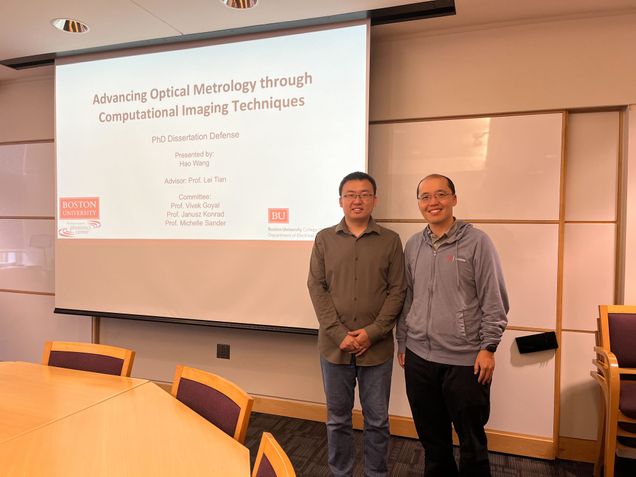7th PhD of Tian lab: Hao Wang. Congratulations!

Wednesday, September 25, 2024
11:00 a.m. – 1:00 p.m
Advancing Optical Metrology Through Computational Imaging Techniques
Committee: Professor Lei Tian, Professor Vivek Goyal, Professor Janusz Konrad, Professor Michelle Sander
Abstract
Optical metrology, which uses light to precisely measure and characterize objects, is essential in industrial manufacturing, scientific research, and engineering design. Computational optical imaging techniques have leveraged novel optical systems, advanced algorithms, and increased computing power to accurately reconstruct and analyze the physical properties of objects, surpassing the capabilities of traditional optical metrology methods. This thesis explores the advancement of optical metrology through computational imaging techniques, focusing on the following three primary research areas.
The first research focuses on semiconductor chip surface topography measurement, which plays a critical role in various semiconductor industrial applications. Conventional optical metrology techniques often face challenges in balancing field-of-view (FOV) and spatial resolution. To overcome these limitations, I propose a novel technique termed Fourier Ptychographic Topography (FPT). FPT provides wide FOV, high resolution, nanoscale height reconstruction accuracy. Experimental validation on a sample semiconductor chip also demonstrates the robustness and superior performance of FPT compared to current standard optical profilometry methods.
In the second study, I extend my research from surface metrology to large-scale 3D particle detection from a single hologram. Traditional 3D particle localization methods often rely on single-scattering models, which are limited in their ability to accurately capture dense particle distributions at deep imaging depths. To address this limitation, I use a multiple-scattering beam propagation method (BPM) to model multiple scattering effect of 3D particle fields. I achieve robust detection of dense 3D particles and experimental results demonstrate that my approach provides significantly higher accuracy compared to conventional single-scattering models, particularly in scenarios with high particle densities and deep imaging depths.
Finally, I explore the application of deep learning methods for phase retrieval, a fundamental problem in computational imaging-based optical metrology. My previous research utilized physical models to simulate the optical imaging process. While these traditional model-based methods achieved state-of-the-art results in many ap-plications, the development of deep learning methods introduces new possibilities for solving highly ill-posed problems that were previously unsolvable. In my third study, I introduce the Neural Phase Retrieval (NeuPh) network, which enables flexible object representations and resolution-enhanced phase reconstruction from multiplexed Fourier ptychographic microscopy (FPM). Experimental results demonstrate the NeuPh networks scalability, robustness, accuracy, and generalizability in solving the highly ill-posed phase retrieval problem, outperforming existing methods and offering potential wide applications in optical metrology techniques.
Through these investigations, this thesis advances optical metrology by integrating computational imaging techniques, offering improved measurement accuracy, scalability, and robustness and paving the way for enhanced optical metrology methodologies in various applications.